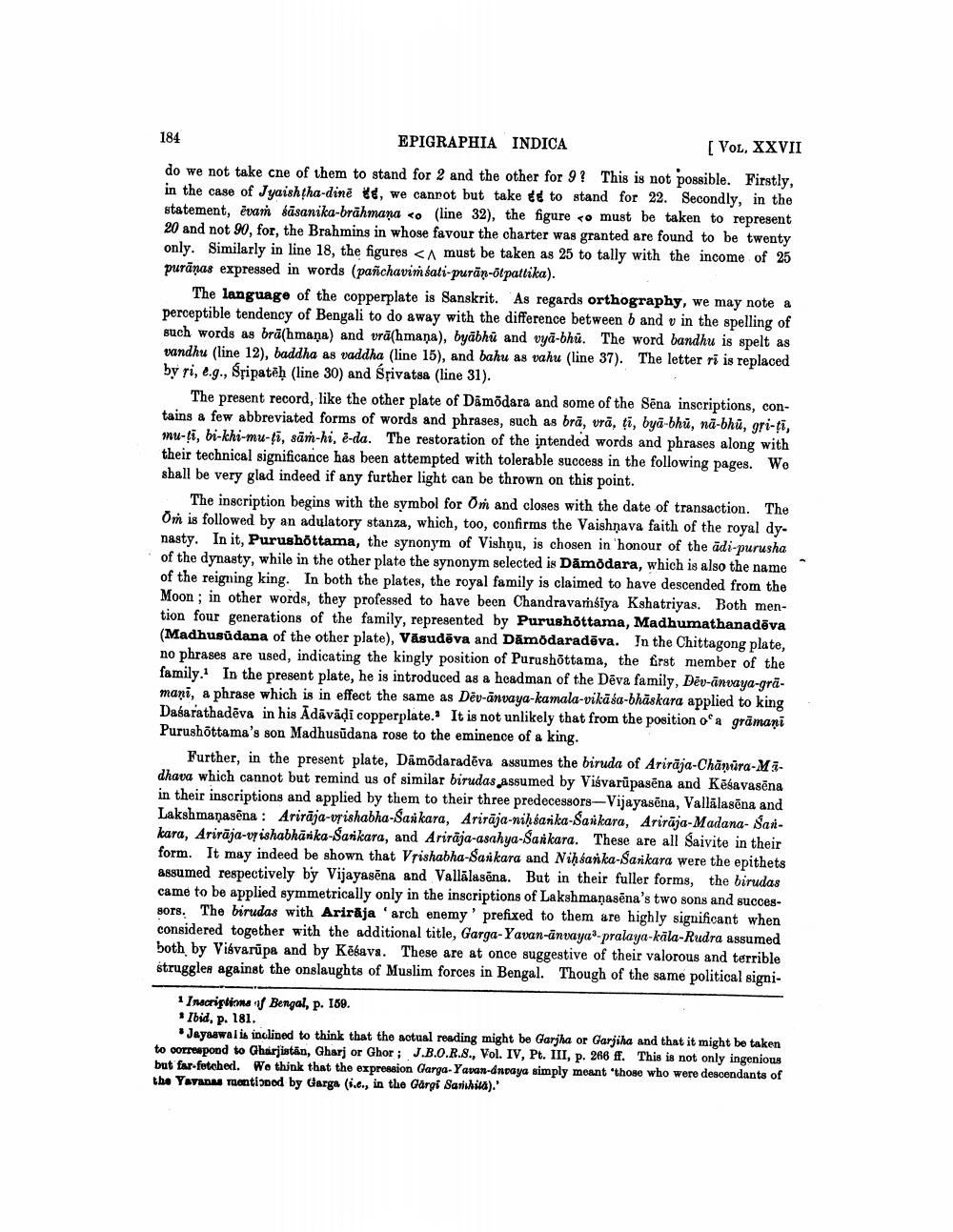________________
184
EPIGRAPHIA INDICA
[ VoL, XXVII
do we not take cne of them to stand for 2 and the other for 9? This is not possible. Firstly, in the case of Jyaishtha-dine te, we cannot but take to stand for 22. Secondly, in the statement, ēvam sāsanika-brāhmana <o (line 32), the figure o must be taken to represent 20 and not 90, for, the Brahmins in whose favour the charter was granted are found to be twenty only. Similarly in line 18, the figures <A must be taken as 25 to tally with the income of 25 purānas expressed in words (pañchaviņsati-purān-otpattika).
The language of the copperplate is Sanskrit. As regards orthography, we may note a perceptible tendency of Bengali to do away with the difference between b and v in the spelling of such words as brā(hmana) and vrä(hmana), byābhū and vyä-bhủ. The word bandhu is spelt as vandhu (line 12), baddha as vaddha (line 15), and bahu as vahu (line 37). The letter ri is replaced by ri, e.g., Sripatēḥ (line 30) and Srivatsa (line 31).
The present record, like the other plate of Damodara and some of the Sēna inscriptions, contains a few abbreviated forms of words and phrases, such as brā, vră, ți, bya-bhū, na-bhū, gri-ti, mu-ti, bi-khi-mu-ti, sāṁ-hi, e-da. The restoration of the intended words and phrases along with their technical significance has been attempted with tolerable success in the following pages. We shall be very glad indeed if any further light can be thrown on this point.
The inscription begins with the symbol for Oń and closes with the date of transaction. The Om is followed by an adulatory stanza, which, too, confirms the Vaishnava faith of the royal dynasty. In it, Purushottama, the synonym of Vishņu, is chosen in 'honour of the ādi-purusha of the dynasty, while in the other plate the synonym selected is Damodara, which is also the name of the reigning king. In both the plates, the royal family is claimed to have descended from the Moon; in other words, they professed to have been Chandravarsiya Kshatriyas. Both mention four generations of the family, represented by Purushottama, Madhumathanadēva (Madhusudana of the other plate), Vāsudēva and Damodaradēva. In the Chittagong plate, no phrases are used, indicating the kingly position of Purushottama, the first member of the family. In the present plate, he is introduced as a headman of the Déva family, Dëv-anvaya-gramani, a phrase which is in effect the same as Dēv-ānvaya-kamala-vikāśa-bhāskara applied to king Dasarathadēva in his Ādāvāļi copperplate. It is not unlikely that from the position ofa grāmani Purushottama's son Madhusūdana rose to the eminence of a king.
Further, in the present plate, Dāmõdaradēva assumes the biruda of Ariraja-Chanura-Mdhava which cannot but remind us of similar birudas assumed by Visvarūpasēna and Kēšavasēna in their inscriptions and applied by them to their three predecessors-Vijayasina, Vallālasēna and Lakshmanasēna : Arirāja-vrishabha-Saskara, Arirāja-niharika-Sarikara, Arirāja-Madana-San kara, Arirāja-vr ishabhārika-Sarikara, and Ariraja-asahya-Sankara. These are all Saivite in their form. It may indeed be shown that Vrishabha-Sankara and Nihtanka-Sarikara were the epithets assumed respectively by Vijayasēna and Vallālasēna. But in their fuller forms, the birudas came to be applied symmetrically only in the inscriptions of Lakshmanasēna's two sons and successors. The birudas with Ariraja 'arch enemy'prefixed to them are highly significant when considered together with the additional title, Garga-Yavan-anvaya..pralaya-kāla-Rudra assumed both by Visvarūpa and by Kēšava. These are at once suggestive of their valorous and terrible struggles against the onslaughts of Muslim forces in Bengal. Though of the same political signi
1 Inscriptions Bengal, p. 169. * Ibid, p. 181.
Jayaswal is inclined to think that the actual reading might be Garjha or Garjiha and that it might be taken to correspond to Ghairjistán, Gharj or Ghor; J.B.O.R.S., Vol. IV, Pt. III, p. 266 ff. This is not only ingenious but far-fetched. We think that the expression Garga Yavan-dnvaya simply meant 'those who were descendants of the Yavanas ruentioned by Garga (s.c., in the Gargi Sarithita).'




